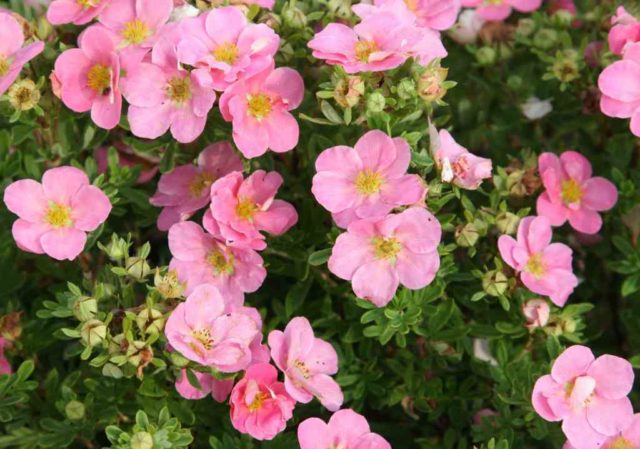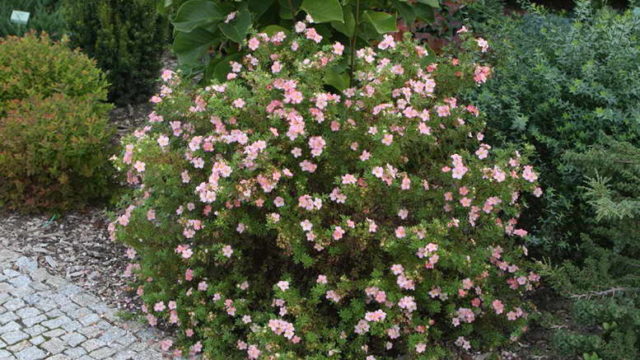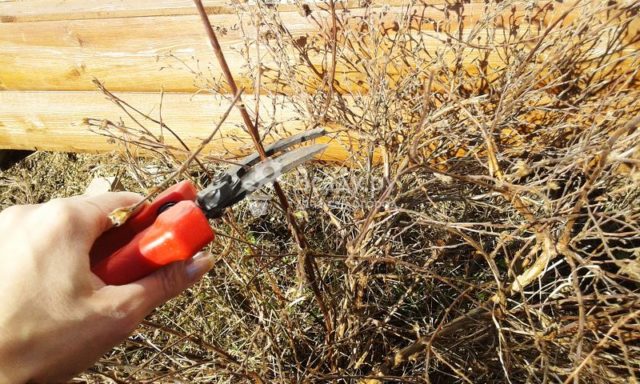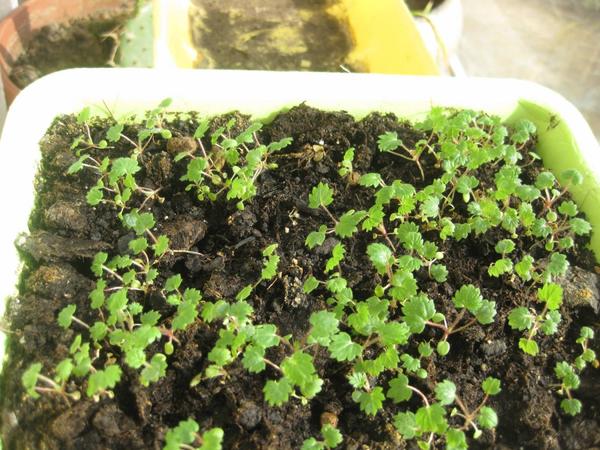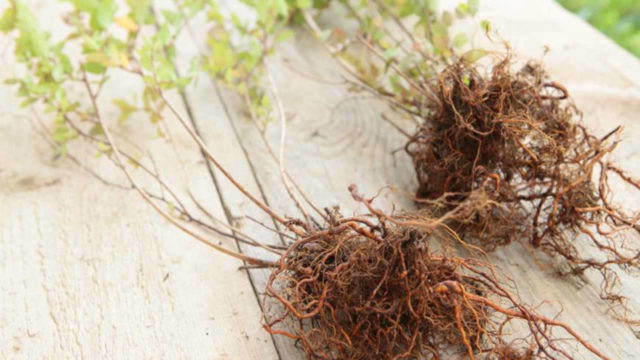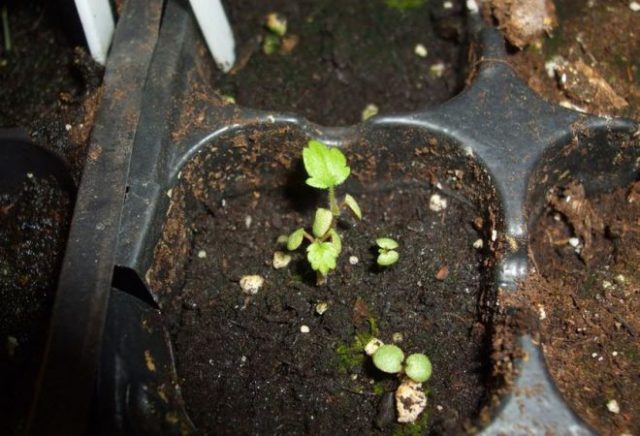Content
For the design of summer cottages and the nearby territory of country houses, according to landscape designers and gardeners, the Pink Queen shrub cinquefoil is best suited. Lush bushes, abundantly strewn with buds of delicate pink shades, are an excellent decoration for any backyard, invariably attract attention and cannot leave anyone indifferent.
Description Potentilla Pink Queen
The name of the variety of Potentilla shrub Pink Queen, or Pink Princess, translates as "Pink Queen", "Pink Princess". There are also some other names for Potentilla - five-leafed plant, dazifora, Kuril tea, mighty, herb-whisper. The Latin name Potentilla means "strength", "power". And it testifies to the beneficial healing properties widely used in folk and scientific medicine.
The Pink Queen shrub originated from wild species and does not need special care. It successfully takes root both in the central part of the mainland and in areas of the northern edge. Medium-sized bushes with creeping branches reach a height of 0.5 - 1 m. With proper care, they add 10 - 15 cm of new shoots every year and are long-livers with a life expectancy of 20 - 30 years.
Cinquefoil Pink Queen stands out from other plants not only for its luxurious appearance, but also for its long flowering period. The first buds appear at the very beginning of summer and continue to delight the eye until the very first frosts. The bushes look like a ball, thanks to the dense lush crown. The leaves of the plant are feathery, hairy, pointed in shape. First they have a green color, then a silver tint is added to it. They grow no more than 3 cm in length and 1 cm in width. Each Potentilla flower has 5 petals and 30 stamens, which give the impression of a fluffy center. The buds reach 3.5 cm in diameter and look very delicate and fragile. Photo of Potentilla Pink Queen conveys all the tenderness and beauty of this variety.
Cinquefoil Pink Queen in landscape design
Due to the interchangeability of flowers during the entire flowering period, the Pink Queen shrub cinquefoil has found wide application in the design and landscaping of garden plots. It can be easily incorporated into any composition, creating a smooth transition between color and shape of plants. With its help, you can create low cutting curbs, arrange rocky gardens. Good Potentilla Pink Queen in the role of tapeworm against the background of lawn grass. In some cases, it can act as a decoration for roofs, slopes, alpine slides.
In park areas, single or group planting of Pink Queen Potentilla is recommended in order to create a flowering undergrowth that does not require special care. Low hedges in the form of a border look beautiful. They are unpretentious, keep their shape for a long time and cut their hair well, and in open spaces and sunny lawns they perform as excellent soloists.
Pink Queen cinquefoil has found application even in Chinese and Japanese gardens, participating in the formation of compact neat geometric shapes and compositions. The combination of Pink Queen shrub Potentilla variety with wildflowers - lemon daylilies, white daisies and blue bells - looks great on a flower bed.The decorative appearance of Potentilla throughout the entire flowering period allows you to successfully include shrubs with delicate pink buds in autumn compositions, playing with the contrast of the foliage of other plants.
Planting and caring for pink queen shrub cinquefoil
Cinquefoil is widespread in nature and is considered an unpretentious plant that can grow in the most unfavorable conditions. Gardeners recommend planting seedlings in early autumn or spring after the night frosts stop. It is better to choose an open, sunny place of landing.
Landing site preparation
Planting and caring for Pink Queen Potentilla is not difficult: even novice gardeners can cope with the basic rules. Ornamental shrubs are undemanding to the type of soil, but they take root better in loose, fresh, moist substrates with good drainage. Before planting, the soil must be dug up and leveled. A slightly acidic soil with a small amount of limestone is best suited. An increased alkali content can lead to yellowing of the leaves.
2 - 3 days before planting, a depression is dug, the size of which should exceed the volume of the roots by 2 times. It is better to use lime gravel as drainage, which supplies the calcium necessary for the growth of a young seedling. The pit is filled with a nutrient mixture obtained from the following components:
- humus - 1 part;
- sheet land - 1 part;
- medium grain sand - ½ part;
- complex mineral dressing - 120 - 140 g.
After the preparation of the planting site, they begin to plant the Pink Queen shrub Potentilla.
Landing rules
Experienced gardeners pour the seeds directly into the prepared soil. For beginners - amateurs it is better to pre-grow seedlings. For this, a wide box with holes is suitable, which is filled with a nutrient mixture consisting of equal parts of humus and peat. The soil is watered, the seeds are covered and covered with a small layer of soil. The box is covered with a transparent plastic bag and left in a warm room at 16 - 18 degrees Celsius.
Seedlings are regularly watered and ventilated. Seedlings grow slowly. The strongest ones, on which 3 leaves have appeared, are planted separately in another container. With the onset of warmth, they can be transplanted into open soil.
The seedlings are placed in the pits, gently spreading the roots. The remaining free space is covered with earth, tamping tightly and avoiding the appearance of air voids. The root collar of the plant should be flush with the soil surface. Only if this condition is fulfilled, the Pink Queen shrub cinquefoil will be able to take root safely. The distance between the pits should be at least 50 cm. After planting, the plants are watered, the adjacent rounded area is mulched with straw, wood chips, grass.
Potentilla seeds can be planted in open ground in the fall. In winter, they accumulate strength for early germination, and in the spring the first leaves are already shown above the ground. They are also planted in the spring.
Watering and feeding
Pink Queen's Cinquefoil can survive in mild drought conditions. But caring gardeners should monitor the level of soil moisture. During the planting of the seedling, the trunk circle is made below ground level. It will serve as a natural funnel for even watering. It is enough to water the Potentilla shrub once every 2 weeks with water, the temperature of which does not differ from the air temperature. It is recommended to pour 10 - 12 liters of water on each bush. Young seedlings should be watered more often - 3 times a week.
Every week, soil is loosened to provide oxygen.When performing such work, care should be taken not to damage the roots of Potentilla.
In the fall and spring, the addition of natural compost will help improve the structure of the soil. During the season, Pink Queen Kuril tea is fed 3-4 times. Regular feeding stimulates the flowering of Potentilla. Fertilizers can be used:
- extract of vermicompost;
- a mixture of ash and mullein;
- complex formulations for flowering plants.
Such drugs are quite effective, easy to use and available to every gardener.
Pruning
To give the Potentilla bushes a beautiful shape, improve flowering and appearance, it is necessary to carry out regular spring pruning until the buds begin to grow actively. In the period from April to May, the branches of the bushes are cut in half. If the shoots are long enough, you can trim 1/3 of the length.
Cinquefoil shrub Pink Queen tolerates haircut well enough and therefore is often used for decoration of land plots.
You can arrange the growth of Potentilla bushes in the form of small trees. For this, several long straight branches are chosen, which are intertwined with each other, and the rest are cut off. Having retreated 40 cm from the soil level, all small branches and buds are removed. The future crown is shortened, leaving shoots no more than 10 cm in length. Such a composition begins to bloom in the first year. In subsequent seasons, they get rid of root shoots and buds appearing on the base branches. Finally, the crown is made out in the spring.
Compact Potentillae should undergo sanitary pruning and stripping of broken, dried out and improperly growing branches. Bushes over 7 years old need to be rejuvenated. To do this, every year it is enough to cut out 1/3 of the old branches until the shrub is completely renewed.
Preparing for winter
Despite the fact that the Pink Queen cinquefoil is a frost-resistant crop, one should not abandon the traditional methods of warming plants for winter. This is especially necessary for young seedlings, which without special preparation can die during their first wintering. Cinquefoil Pink Queen, growing in harsh climatic conditions, will also not be able to withstand low temperature extremes on its own.
Young seedlings huddle well and cover the lower bare branches with a layer of soil. The trunk circle is covered with humus or peat. After the preparatory work carried out, the cinquefoil can be covered with any protective material or spruce branches. The covering structure must have a sufficient level of air permeability so that the Potentilla shrub does not overheat during possible thaws or does not begin to rot due to lack of air.
In the middle lane and temperate climate, adult pink queen Potentilla bushes can be left for the winter without additional shelter. It is enough to remove the fallen leaves in a timely manner to prevent decay processes.
Reproduction of Potentilla Pink Queen
Cinquefoil can propagate by seeds and in several other ways:
- Simplest - reproduction by layering. In the spring, the selected shoots of Potentilla Pink Queen are incised, leaned against the ground with the incised edge and sprinkled with soil. After the appearance of their own roots, the layers are separated from the main plant and planted separately.
- Division of bushes. For this, pink Queen Potentilla bushes over 4 years old are suitable. The roots are washed well and cut into pieces, each of which should contain 2 - 3 buds. After that, the separated parts are planted in the ground, leaving the buds on top of the ground at a distance of about 30 cm. Cinquefoil will bloom in 2 - 3 years after planting.
- Cuttings Is another common way to get new green plants. From the end of June to July, young shoots are cut and placed under a film or in a greenhouse. To create the necessary moisture, a shelter from a can or plastic bottle is suitable. After 2 weeks, new shoots will appear. They can be planted immediately or left for the winter until next season.It is better to pick the buds that have appeared so that the young Pink Queen cinquefoil retains its strength.
Diseases and pests
The description of the Pink Princess Potentilla variety will be incomplete, if not to say its resistance not only to frost, but also to pests, as well as various diseases. In rare cases, Pink Queen cinquefoil can be exposed to powdery mildew, as a result of which the plant becomes covered with a white bloom. In the fight against this fungal disease, fungicidal agents will help.
The appearance of spots of a yellow-violet hue indicates the defeat of Pink Queen's Potentilla by rust. But this disease does not cause significant harm. To help cinquefoil in resisting various diseases of a fungal nature, you can carry out foliar treatment with boric acid or potassium permanganate.
Conclusion
Cinquefoil Pink Queen is a very beautiful unpretentious plant with graceful pink buds, which can become a real decoration of any garden plot. Immunity to various diseases and pests, as well as frost resistance and the ability to take root in any climatic conditions make this crop especially valuable for cultivation in the climatic conditions of Russia.
